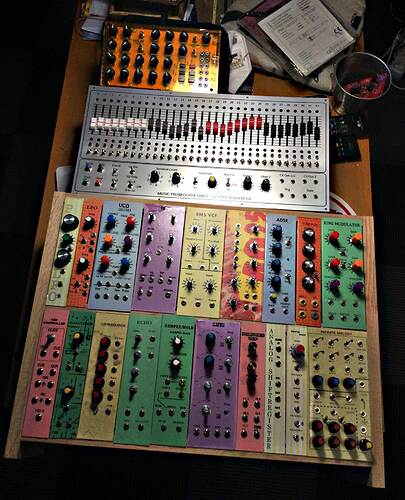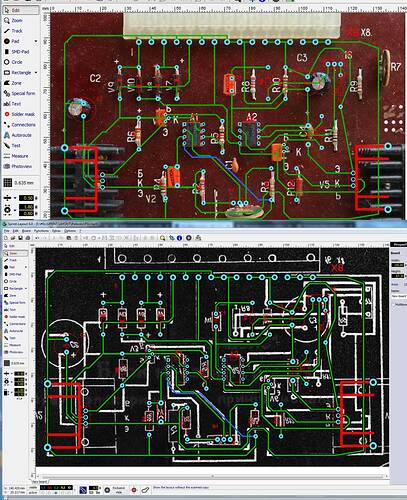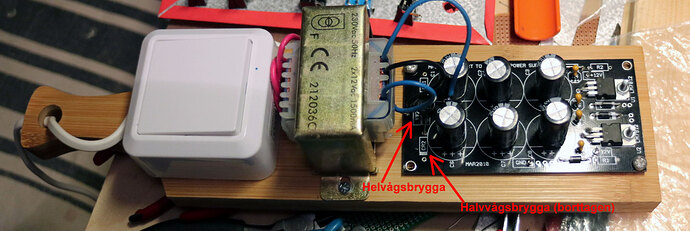Disclaimer: There will probably not be a finish to neither this thread nor the modulare synthsesizer I ACCIDENTLY (I have to stress accidently) started to build, either a year or seven years ago - have a pick!
I suffered my first heart arrest in 2006 and the second, that nearly shipped me 8 ft beneath Earth’s surface. Both of them have made bad things to my normal letargy and I have so difficult finishing my projects and that’s much how this one came to be …
So starting from the beginning.
I did find Ray Wilson’s MFOS and got me the Soundlab ver 0.0 (and later Mk 2). However sometime while trying to finish those two projects I ran into the modules from CGS and just had to have the analog shiftregister and the digital noise generator. These modules may have been purchased some 7-8 years ago, I cannot remember really.
Fast forward.
I March 2020 I ended up with a Concertmate MG-1 and tried to copy the PCB, using more available potentiometers and switches, but ran out of energy and instead turned my eyes to different modules that could do the job a bit better (differently) and had in a few weeks time finished Gerber files for some basic modules:
Yusynth’s VCOs with 2SC1583 and LM394
Yusynth’s EMS VCF Clone
Yusynth’s S&H & noise module
Yusynth’s ADSR
Thomas Henry’s VCA
MFOS’ Ring modulator
MFOS’ dual LFO
Scott Barnardi’s Echo module
Adding two modules from Barton - Quantizers and Arpeggiator. The quantizers will work great with sequenzers!
Other modules from CGS - Infinity Melody, PsychLFO and the tube VCA.
And from an earlier purchase I had to add MFOS’ keyboard controller. I stuff this one into the rack so I can use it with a keybard as well as a ribbon.
So this projects lives its very own life or as we say here in Sweden - “Give the devil a finger and he takes your whole arm …”.
Much like the theory for the Big Bang, I have just passed the uncontrollable expansion phase, where I have horded modules rather randomly and haven’t really decided where to go, where to stop, what to do with this machine but I have some ideas …
IDEAS
I am not a musician, though I have several synthesizers and a kit-built Tender Stratovarius, but I love making sounds sooooo … let the electronics do the playing!
The collection of unfinished stuff also contains Ray Wilson’s 32-step sequenzer and I just order PCBs for Thomas Henry’s SuperSeque. One idea is to let several units like the sequencers and the Infinite Melody do a lof of job and use all my modules to tinker with the sounds and successively learn to master a keyboard and a guitar. I have enuff of stuff to do a good job, so if I loose my head and add more (odd) modules, they will just be “the whipped cream on the mashed potatoes” (“icing on the cake” in Swedish).
Before I go and get my laundry, one short construction note.
Finding good hard 2mm aluminium isn’t that easy where I live and as I have unlimited access to alu/zink alloy sheet metal, that is rather thin (got several scars here and there) from my last work place, I use that, hoping that it will be solid enough when screwed into my rack. I picked an odd 7" standard out of some reason (= narrow panels). The panels are drilled and covered with coloured paper with texts and symbols using spray glue and then covered in clear varnish.
I make this synthesizer for ME, myself and I, and I have no objections if it looks a lot like the sounds (and music) it hopefully will produce.
What’s next?
I will try to report how the work proceeds, the problems I run into and maybe cry for help, especially when I cannot come to a decision on certain topics, like powering the modules. They run on +/-12V and +/-15V, some have 12V and 15V regulator ICs installed which means I have to have additional +/-18V raw DC …
Gotta run, and here’s todays shot of how things look like.
One more thing (my laundry will be super dry), I hope I can be of help in here as well as picking up ideas and tips.



 Have to swap the little transformer shown above. Happened to release the electronic smoke inside it …
Have to swap the little transformer shown above. Happened to release the electronic smoke inside it …
 )
)

 ). But still a lot of other things to deal with.
). But still a lot of other things to deal with.
 ), my corsets (that I have sewn) AND my synthesizers
), my corsets (that I have sewn) AND my synthesizers  . We had some great time talking and taking weid photos. When the paper comes out (named Door Post) I will share it with you.
. We had some great time talking and taking weid photos. When the paper comes out (named Door Post) I will share it with you.

